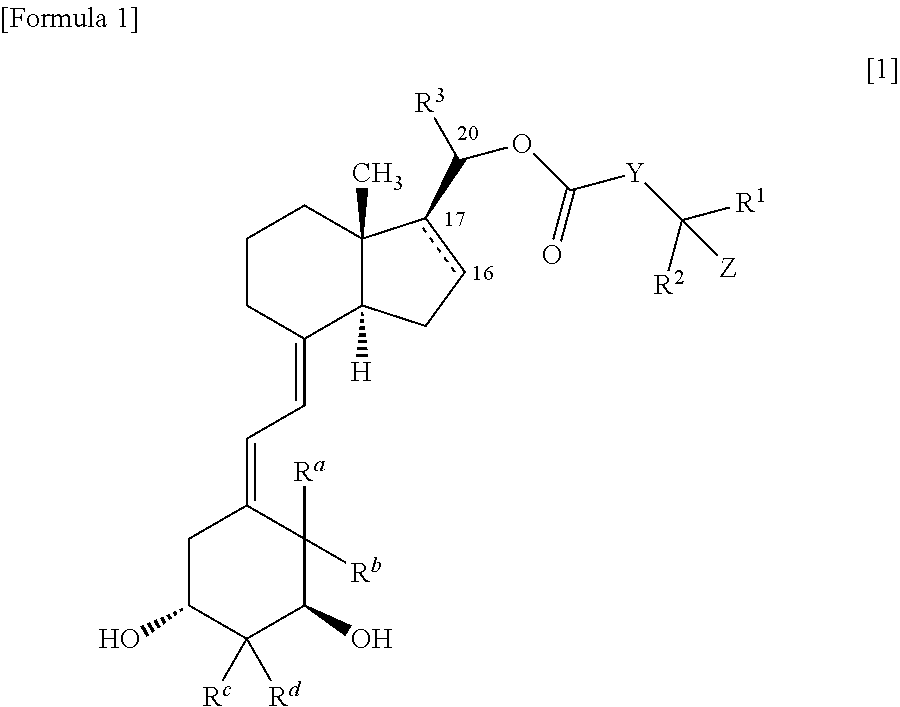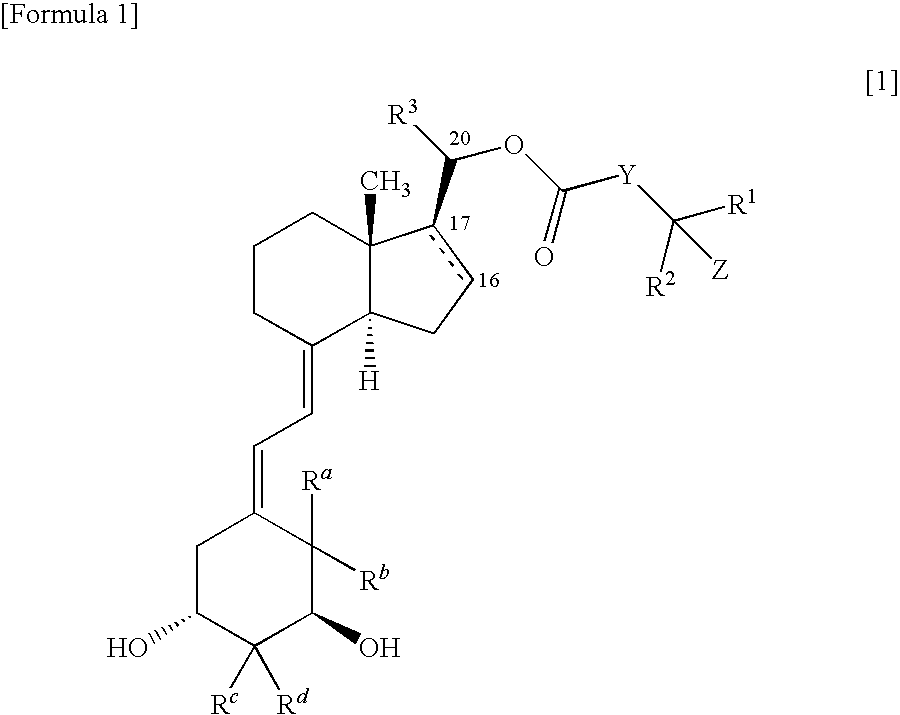9, 10-secopregnane derivative and pharmaceutical
- Summary
- Abstract
- Description
- Claims
- Application Information
AI Technical Summary
Benefits of technology
Problems solved by technology
Method used
Image
Examples
reference example 1
3-(t-butyldimethylsilyloxy)-3-methylbutyric acid
Step 1:
[0149]4-Dimethylaminopyridine (0.78 g) was added to an anhydrous methylene chloride solution of 3-hydroxy-3-methylbutyric acid (3.76 g) and benzyl alcohol (4.13 g), and stirred with cooling on ice. N,N′-dicyclohexylcarbodiimide (9.9 g) was added thereto, then the ice bath was removed, and stirred overnight at room temperature. The precipitated insoluble matter was removed by filtration, and the mother liquid was concentrated to give a residual oil (13 g). This was purified through silica gel column chromatography to give benzyl 3-hydroxy-3-ethylbutyrate (7.2 g) as a pale yellow oil.
[0150]1H-NMR (CDCl3) δ: 1.28 (6H, s), 2.55 (2H, s), 5.16 (2H, s), 7.36 (5H, s)
Step 2:
[0151]2,6-Lutidine (3.6 g) was added to an anhydrous methylene chloride solution of benzyl 3-hydroxy-3-methylbutyrate (3.5 g) obtained in the step 1, and stirred with cooling with ice. t-butyldimethylsilyl trifluoromethanesulfonate (3.9 mL) was gradually added dropwis...
reference example 2
(1S,3R,20S)-1,3-bis(t-butyldimethylsilyloxy)-9,10-secopregna-5Z,7E,10(19)-triene-20-ol
[0155]A tetrahydrofuran solution (500 mL) of (1S,3R,20S)-1,3-bis(t-butyldimethylsilyloxy)-pregna-5,7-dien-20-ol (155 mg) (its production method is, for example, described in Non-Patent Reference 23) was bubbled with argon gas with cooling on ice for 10 minutes. Next, a 500-W high-pressure mercury lamp of which the cooling layer was circulated with a filter solution of nickel sulfate-copper sulfate (it is described, for example, in Non-Patent Reference 24) was inserted into the reaction bath and irradiation with light was performed for 5 minutes with cooling on ice. The reaction liquid was further irradiated for 2.5 minutes, and then transferred into a brown flask and refluxed for 3 hours. The solvent was evaporated away under reduced pressure, and the residue was purified through silica gel column chromatography and preparative thin-layer chromatography to give the entitled compound (30 mg) as a co...
example 1
(1S,3R,20S)-20-(4-hydroxy-4-methylpentanoyloxy)-9,10-secopregna-5Z,7E,10(19)-triene-1,3-diol
Step 1:
[0157]2,4,6-Trichlorobenzoyl chloride (13 μL) was added to a tetrahydrofuran solution (0.5 mL) of 4-triethylsilyloxy-4-methylpentanoic acid (20 mg) produced according to the method described in Non-Patent Reference 25 and triethylamine (11.2 μL), and stirred at room temperature for 30 minutes. After the precipitated crystal was removed by filtration, tetrahydrofuran was evaporated away, and the residue was dried under reduced pressure. An anhydrous benzene solution (0.5 mL) of (1S,3R,20S)-1,3-bis(t-butyldimethylsilyloxy)-9,10-secopregna-5Z,7E,10(19)-triene-20-ol (30 mg) obtained in Reference Example 2, and 4-dimethylaminopyridine (30 mg) were added to the residue in an argon gas atmosphere, and stirred at room temperature for 30 minutes. The reaction liquid was diluted with ethyl acetate, then washed with aqueous saturated sodium hydrogencarbonate solution and saturated saline in that ...
PUM
 Login to View More
Login to View More Abstract
Description
Claims
Application Information
 Login to View More
Login to View More - R&D
- Intellectual Property
- Life Sciences
- Materials
- Tech Scout
- Unparalleled Data Quality
- Higher Quality Content
- 60% Fewer Hallucinations
Browse by: Latest US Patents, China's latest patents, Technical Efficacy Thesaurus, Application Domain, Technology Topic, Popular Technical Reports.
© 2025 PatSnap. All rights reserved.Legal|Privacy policy|Modern Slavery Act Transparency Statement|Sitemap|About US| Contact US: help@patsnap.com



